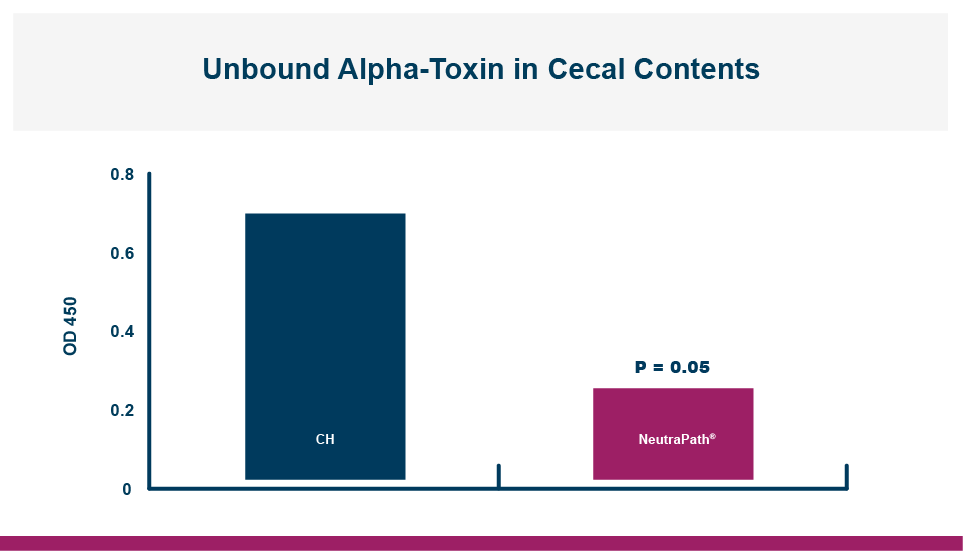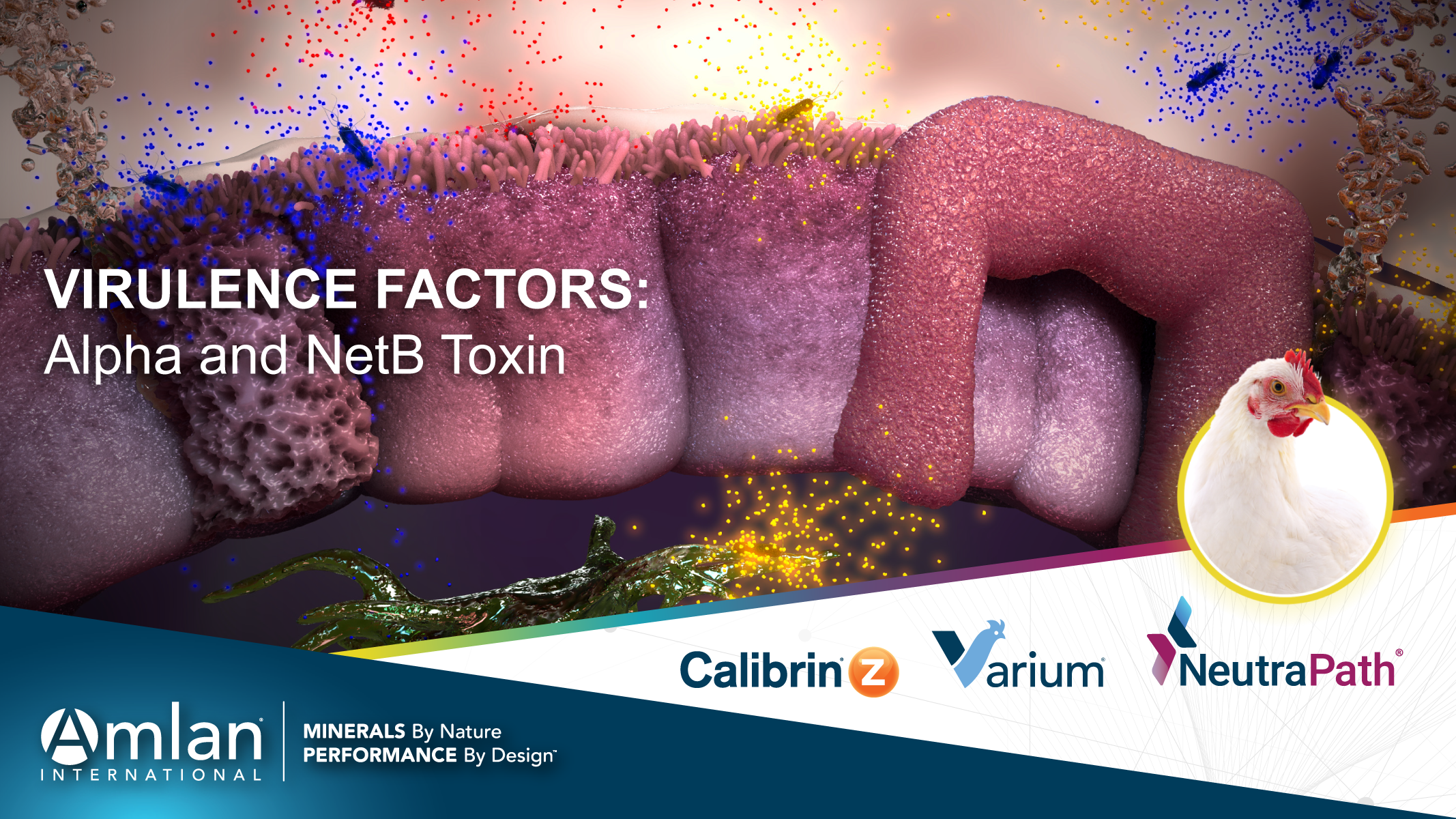Necrotic enteritis is a common — and costly — infectious disease of poultry caused by the gram-positive bacteria Clostridium perfringens. The virulence of C. perfringens is mostly related to its ability to produce potent toxins. Two exotoxins in particular — alpha-toxin and necrotic enteritis B-like toxin (NetB) — play critical roles in necrotic enteritis development in poultry.
Necrotic Enteritis Origins
The anaerobic, spore-forming C. perfringens is found throughout the poultry environment and is also part of the normal bird microbiota. Necrotic enteritis occurs when there is an overgrowth of C. perfringens caused by predisposing conditions, such as diet changes, immune status or intestinal pathophysiology. High mortality rates are characteristic of the clinical form of necrotic enteritis, whereas subclinical disease causes reduced weight gain and higher feed conversion ratio (FCR). The increased FCR is due to reduced nutrient digestibility and adsorption, and the subsequent compensatory feed intake.
The Role of Exotoxins in Necrotic Enteritis
C. perfringens produces multiple exotoxins, including alpha-toxin and NetB toxin. All C. perfringens types produce alpha-toxin which is cytotoxic to endothelial cells, red blood cells, white blood cells and platelets.1 Alpha-toxin was thought to be the major toxin responsible for necrotic enteritis clinical signs; however, researchers identified an alpha-toxin-negative mutant strain that was able to induce necrotic enteritis.2 This led to the discovery that NetB was a key virulence factor of necrotic enteritis in poultry.
Quorum sensing regulates NetB production, which is initiated when C. perfringens reaches a concentration of 109 CFU/g or higher and the bird has dysbiosis or impaired intestinal function.3 In healthy birds, the intestinal epithelium and mucus layer protect internal tissues by forming a selective barrier against the contents of the intestinal lumen (the external environment). The natural barrier allows nutrients through the intestinal wall but not pathogens and their toxins. A breakdown of this defensive barrier occurs when there is an overgrowth of C. perfringens and toxin production is stimulated. NetB forms pores in cell membranes that allow electrolytes to rupture cells, causing cell death and necrotic lesions in the small intestinal mucosa.1 The damage to the intestinal wall hinders nutrient digestion and absorption and can allow toxins to enter the circulatory system.
Manage Necrotic Enteritis with Natural Mineral-Based Feed Additives
Effective management programs are important for reducing the harmful health and production effects of necrotic enteritis. However, neutralizing the toxins produced by C. perfringens can also help control necrotic enteritis. The natural mineral-based feed additives Varium®, NeutraPath® and Calibrin®-Z (all available in select international markets) can be used alone or in synergistic combination to help maintain a healthy intestinal environment and protect birds from the devastating effects of alpha-toxin and NetB toxin.
Designed specifically for poultry, patented Varium promotes bird efficiency and productivity by protecting the intestinal lining, strengthening the intestinal barrier and stimulating the intestinal immune system. Varium’s synergistic, mineral-based formulation does this by binding pathogenic bacteria and the toxins they produce, energizing intestinal epithelial cells and acting as an immunomodulator to help birds naturally combat disease.
NeutraPath helps support broiler gut health and structural integrity by reducing the intestinal load and colonization of pathogenic bacteria. NeutraPath has bacteriostatic and bactericidal properties and can also neutralize virulence factors, including the toxins produced by pathogenic bacteria and the quorum-sensing molecules used for pathogen communication.
Calibrin®-Z is a single-ingredient, all-natural biotoxin binder that helps protect the intestinal barrier against enteric disease. Calibrin-Z can bind a broad spectrum of pathogens and bacterial and fungal toxins, including C. perfringens and E. coli toxins and aflatoxin, fumonisin and zearalenone.
Natural Mineral-Based Feed Additives Bind C. perfringens-produced Toxins
were shown to effectively bind alpha-toxin and NetB toxin in vitro (Figure 1), and NeutraPath caused a four-fold reduction in unbound alpha-toxin in the cecal contents of C. perfringens-challenged broilers (Figure 2). These alpha-toxin and NetB toxin binding abilities also translated to health and performance improvements during .

Figure 1: Researchers at the United States Department of Agriculture – Agricultural Research Service (USDA-ARS) showed that Varium and Calibrin-Z were able to effectively bind alpha-toxin and NetB toxin in vitro.

Figure 2: A four-fold reduction in unbound alpha-toxin occurred in cecal contents of C. perfringens-challenged broilers fed NeutraPath compared to challenged control birds (128 total birds). Source: Southern Poultry Research, Inc., Athens, GA.
The C. perfringens toxins associated with the development of necrotic enteritis — alpha-toxin and NetB toxin — can have devastating effects on the health and production performance of poultry. However, the natural mineral-based feed additives Varium, NeutraPath and Calibrin-Z can help neutralize these toxins, protect the intestinal environment and improve production efficiency. To learn more about these intestinal health solutions, contact your local Amlan representative.
References
- Chi F. A Viable Adjunct or Alternative to Antibiotics: Meta-Analysis of Broiler Research Shows Natural Growth Promoter Delivers Feed Efficiency Equal to Antibiotics. Amlan International.
- Keyburn AL, Sheedy S, Ford M, Williamson M, Awad M, Rood J, Moore RJ. Alpha-toxin of Clostridium perfringens is not an essential virulence factor in necrotic enteritis in chickens. Infect Immun. 2006;74:6496-6500.
- Mora ZV, Macías-Rodríguez ME, Arratia-Quijada J, Gonzalez-Torres YS, Nuño K, Villarruel-López A. Clostridium perfringensas Foodborne Pathogen in Broiler Production: Pathophysiology and Potential Strategies for Controlling Necrotic Enteritis. Animals (Basel). 2020;10:1718.

